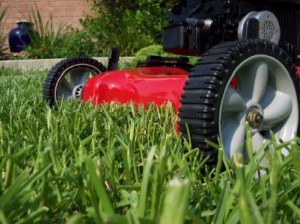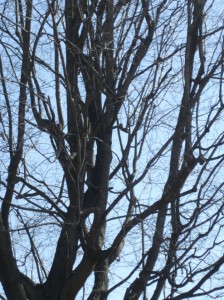 There are a lot of hard-to-kill practices in the lawn and garden that no longer are desired or needed. Here are some examples:
There are a lot of hard-to-kill practices in the lawn and garden that no longer are desired or needed. Here are some examples:
- Gypsum: Once highly recommended, this additive rarely gets the thumbs up in Indiana. Gypsum is high in calcium and our clay soil usually has plenty. Eastern gardeners, with acidic soil, apply gypsum to make the soil more alkaline or raise pH. Soil that is too acidic or alkaline interferes with a plant’s ability to take up nutrients. Save your money and always have your soil tested before adding any pH-altering products. For more info: Iowa State University Extension’s The Use of Gypsum and Lime on Lawns and Gardens.
- Tree topping: Never top a tree. Topping used to be a common practice, but no longer. No certified arborist will recommend topping.

Topping trees promotes weak growth. (C) Jo Ellen Meyers Sharp
We’ve learned that topping actually hastens a tree’s demise. The tree cannot heal the large, gaping wounds from topping, leaving it susceptible to insects and diseases. Also, the abberant-branch growth at the cuts is weak and easily damaged in wind. Instead of topping, use selective pruning methods. For more info: Trees Are Good.
- Mowing height: Set your mower at 3 1/2 to 4 inches and leave it. Cutting the grass shorter may reduce mowing duties, but it opens the lawn up for sun- or wind-scald, weeds, insects and diseases. Lawns kept in the 3- to 4-inch range shade out weeds while moderating the soil’s moisture and temperature. For more info: Purdue University’s Mowing.
- Fertilizers A: People are right when they say plants cannot tell the difference between synthetic and natural fertilizers, but, the soil can. Natural or organic fertilizers feed micro-organisms with soil-building nutrients. Healthy soil yields healthy plants. For more info: Virginia Tech’s Organic Fertilizers.
- Fertilizers B: If you applied a lawn fertilizer in fall, you can easily skip an application in spring and save money. As the weather warms up, the grass is going to grow with or without the fertilizer. A spring application of fertilizer increases mowing duties.
- Wood ash: Has trace amounts of nutrients, but mostly calcium carbonate, which will increase the pH, or alkalinity of the soil. A light dusting is all right, but heavy applications are not recommended. For more info: Purdue University’s Wood Ash in the Garden.